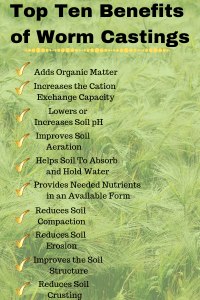6 Simple Techniques For North Carolina Worms
6 Simple Techniques For North Carolina Worms
Blog Article
Some Of North Carolina Worms
Table of ContentsHow North Carolina Worms can Save You Time, Stress, and Money.What Does North Carolina Worms Do?The Buzz on North Carolina WormsRumored Buzz on North Carolina Worms
Instance: 1-gallon of worm castings to 4 gallons of potting mix. 1/2 cup in the base of the growing hole for smaller plants. 1 mug for bigger plants.
The enhancement of tea can additionally add raised microbial biomass to your dirt. You can always side-dress your plants with worm spreadings at any type of time. Simply keep in mind, the microorganisms will certainly pass away if revealed to UV rays (Sun), so make certain to cover the spreadings with an inch or so of dirt.
This frustrated them for several years up until the screening techniques progressed. They found that plant development and health showed a Bell Curve. It would certainly improve(with more spreadings), level off, and after that decrease. They were perplexed. They finally uncovered that excess plant-growth hormones were the perpetrator. Too lots of worm castings would certainly increase the growth to a speed that the plant can not recover from.
The Main Principles Of North Carolina Worms
I have expounded the merits of worm spreadings for concerning 2000 words. Worm spreadings are no different. It takes time to produce quality worm castings.
Worm spreadings certainly set you back more than chemical fertilizers. Worm spreadings are on the less expensive end of organic plant foods. (50 gallons per year) It is a much more difficult and really costly investment to create large quantities of worm castings.

Developing a healthy soil may be the best benefit of worm spreadings. We talked about worm spreadings NPK and also the correct nutrient analysis that must use to worm castings.
The North Carolina Worms Diaries
We talked about some of the drawbacks associated with worm castings. I covered a lot of material in this article.
The vertical burrows are typically open, although the worms cover the leading with residue and excrement. Origins require oxygen for their growth, whereas they produce carbon dioxide that requires to leave the dirt.
Earthworms enhance porosity by two devices: (1) by developing long-term burrows, and (2) by improving dirt gathering. Gathering is boosted by the mixing of soil and natural issue in the earthworms' digestive tracts. North Carolina Worms. These very steady aggregates are transferred by some earthworms in their burrows, and by others at the surface of the dirt


In another research study, earthworms were approximated to eat 4 to 10 percent of the leading 6 inches of the dirt annually. This only goes to show the massive quantities of dirt that can be refined by earthworms. Dirt compaction lowers the porosity of the soil. Due to the fact that earthworms boost porosity, they lower the effects of compaction.
North Carolina Worms for Beginners
Common earthworm populaces can quickly consume 2 bunches of dry matter per acre annually, partly absorbing and mixing it with soil. The relevance of earthworms to blend surface deposit with dirt becomes very clear in dirts that do not have any earthworms. Many of our Pennsylvania dirts have at the very least some earthworms, and the impact of their complete lack, for that reason, can not be noted.
(https://www.poordirectory.com/North-Carolina-Worms_456280.html)In these dirts, the development of topsoil with reasonable organic issue web content did not happen, resulting in poor plant development. As soon as the reason was developed, the government of the Netherlands started a campaign to introduce earthworms. After the introduction of the earthworms, a dark topsoil layer was created, and plant development boosted significantly.
They live mostly from partially decomposed natural matter that is currently integrated in the dirt. These types consume huge amounts of soil that they mix with digested plant deposit in their digestive tracts.
Their burrows stay open, although they cap the leading with crop deposit that they pull to the entrance. These varieties ingest substantial quantities of soil that they blend with digested residue in their intestines. Their excrement is largely transferred at the surface of the dirt. The nightcrawler Lumbricus terrestris is the most noticeable member of this team.
Report this page